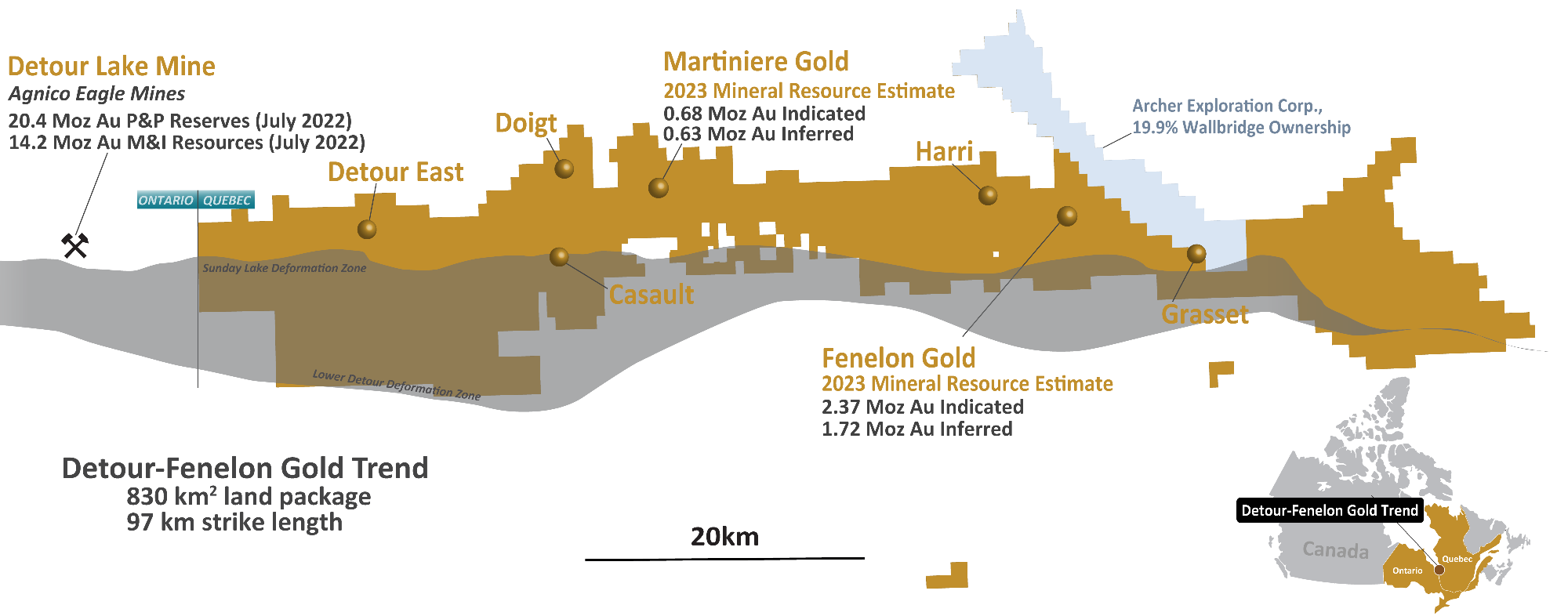Wallbridge Mining Company Limited (“Wallbridge” or the “Company”) is delighted to report the initiation of its 2023 drill program to assess new exploration targets around the 2023 Mineral Resource Estimate (“MRE”) footprint at its Fenelon gold project (“Fenelon”), along with exploration drilling at Martiniere and other potential greenfield targets on the Detour-Fenelon Gold Trend Property of the Company.

Wallbridge’s Detour-Fenelon Gold Trend land package. Image Credits: Wallbridge Mining Company Ltd
Three drills to Fenelon were mobilized by Wallbridge in February to assess a few of the prospective regions around the current deposit, which are detailed more elaborately below. These were made by the interpretation of integrated geophysical and geologic data as well as, where present, historic drill findings.
In addition to drilling in the vicinity of the Fenelon deposit targeting larger step-outs on the existing zones (see March 6, 2023 Press Release), our 2023 drill program is testing various targets on a regional scale. These will focus on areas of promising geology such as favorable host rocks and structures with the objective of identifying new zones of mineralization elsewhere on the Company’s 830 km2 Detour-Fenelon Gold Trend Property. In April two of the drills will be mobilized to Martiniere to commence exploration drilling with similar objectives of assessing the deposit’s size potential and discovery of nearby zones.
Attila Péntek, Vice President, Exploration, Wallbridge Mining Company Ltd
2023 Fenelon Exploration Drill Targets
At Fenelon, the Jeremie Diorite has been found to be an important host rock for gold mineralization, which is related to quartz veining in the body itself (Area 51 and Ripley), and also into the sediments (Tabasco and Cayenne) and along the contact of the intrusion (Contact Zone).
Besides the diorite, the Jeremie Fault characterizes another main control on the gold mineralization distribution. It is inferred as a long-lived fault having several stages of activation. One of these stages is understood to be associated with the mineralizing event.
At Fenelon, the 2023 drill program will concentrate on assessing exploration targets on the property with knowledge that has been achieved by the development of the Fenelon resource ever since its discovery. Besides the immediate extensions of recognized zones, many targets have been found in the region around the Fenelon deposit, which can be of interest for the 2023 program:
Target (1) Northwest magnetic low: This target was found by the re-processing of the 2020 drone-magnetics data, thereby showing geophysical signatures that can be compared to the Jeremie Diorite. Preliminary findings from the first two 2023 drill holes testing this target region have intersected a unit that is comparable to the Jeremie Diorite visually, with an alteration zone containing trace chalcopyrite mineralization. Such findings have put forth a huge area of favorable geology for further study.
Target (2) West magnetic fold: The hinges of folds serve a key purpose in regulating gold mineralization in several orogenic gold deposits. A likely fold hinge has been discovered by geophysics, around 3 km to the west of the deposit.
Target (3) Jeremie Fault corridor to the west: The Jeremie Fault is interpreted depending on magnetic signatures to extend multiple kilometers over the western limits of the Fenelon deposit.
Target (4) Magnetic high and electro-magnetic (“EM”) plates: A huge sulfide layer, like the one occurring next to the Fenelon deposit, showing strong EM and magnetic responses can be traced along the property that offer new exploration targets to the east.
Target (5) Jeremie Fault corridor to the east: This target is straightaway southeast of, and believed to be within, the same geologically favorable gold hosting environment as Target 4.
Target (6) East magnetic low: A magnetic low is found around 3–4 km to the east of the deposit, which has an identical signature to the Jeremie Diorite with a corresponding E-W structure.